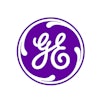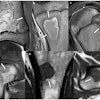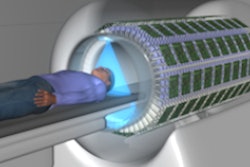
A high-resolution total-body PET scanner, which will be the first of its kind in Europe, is being developed through a collaboration between Ghent University and the Vrije Universiteit Brussels, both in Belgium. The machine -- dubbed PET20.0 -- will be completed by 2020, and will offer higher resolution scanning suitable for pediatric patients.
In therapies for cancer and blood disorders, PET/CT scanners are commonly used for patient diagnosis and treatment monitoring. Children, however, are especially sensitive to radiation, making PET/CT scans more risky. One way to address this is to increase the sensitivity of the scanner. This can be achieved by increasing the field-of-view: with every doubling of the scanner field, the sensitivity is quadrupled.
This is the approach taken by the PET20.0 scanner, which has a 2-m field-of-view, affording a 20-fold increase in sensitivity when compared with current PET scanners. The advantage of total-body scanning, explained PET20.0 developer Stefaan Vandenberghe, a professor in the department of electronics and information systems at Ghent University, is "the combination of very high sensitivity due to the large axial acceptance angle, and the very good and uniform spatial resolution of 2 mm."
The inner diameter of the detector will be 65 cm, with an axial length of 1 m and the option to extend this by a further meter. The compact gantry is planned to have a transverse outer diameter of less than 2 m. The design is expected to be able to perform a total body scan in around just 20 sec -- rapid enough to be undertaken within a single breath hold for nearly all patients.
When finished, the scanner will be installed in the Ghent University Hospital. The researchers anticipate completing the PET20.0 scanner by 2020, with little technical challenges to overcome on the hardware side. The only drawback is the machine is expected to cost around 5 million to 6 million euros, about three times more than current PET/CT scanners and just above the commercial price of a simultaneous time-of-flight PET/MRI.
In comparison with the Explorer PET system -- a full-body scanner being developed at the University of California, Davis in the U.S. -- the PET20.0 will have a shorter axial field-of-view (with 1-m detectors only). The use of monolithic detector crystals with advanced positioning methods will offer improved spatial resolution: 2.0 mm with PET20.0, compared with 3.5 mm in the Explorer.
Alongside improving imaging quality for juvenile patients, the researchers report the PET20.0 will find unique applications in monitoring the effect of innovative treatment plans --- in such areas as chemotherapy and conventional radiotherapy -- as well as for conducting fundamental research into the functioning of humans, animals, and other biological matter.
© IOP Publishing Limited. Republished with permission from medicalphysicsweb, a community website covering fundamental research and emerging technologies in medical imaging and radiation therapy.



















